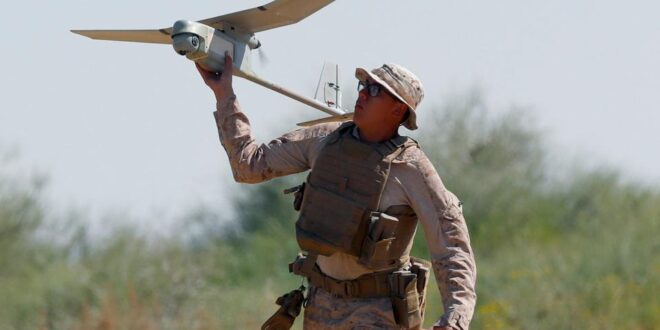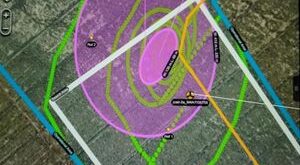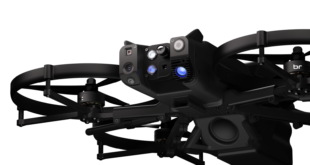U.S. Special Forces are acquiring small drones equipped with electronic jammers under a program known as Project Hornet. Scant details of this previously unknown project are given in a Pentagon budget document.
The RQ-11 Raven Unmanned Aerial Vehicle used by U.S. Special Forces can take various payloads and is … [+]
The R&D budget estimate for the inter-service Office of the Secretary of Defense, describes Project Hornet as “an advanced, hand-launched unmanned aerial system (UAS) that can be used by forward-deployed personnel to interdict and disrupt adversary electronic capabilities in contested environments.”
The key phrase here is ‘contested environments.’ In many theaters of operations, the U.S. enjoys complete control of the airspace. In this situation, airborne assets such as the EC-130H Compass Call – a Hercules aircraft packed with advanced technology – would provide electronic warfare support, able to detect, intercept, locate and jam radio signals of all types. In less accessible places, MQ-9 Reaper drones equipped with electronic warfare pods might be available. A ‘contested environment’ is one where friendly aircraft cannot operate easily, and that’s where Special Forces may need to carry their own air power.
U.S. Special Operations Command operates hundreds of small tactical drones, from palm-sized helicopters to quadcopters to large fixed-wing drones, and uses them extensively for intelligence gathering. They are also major users of the portable, tube-launched SwitchBlade strike drone. Adding jamming into the mix is a logical extension of their capabilities. One possible platform is the widely-used RQ-11 Raven, a miniature aircraft weighing four pounds which flies for up to 90 minutes.
The document states, “The UAS platform provides Special Operations Forces (SOF), along with Service and Interagency partners, with a versatile, adaptive capability that can be applied to a diverse range of adversary electronic threats.”
While the most obvious use is communications jamming, it is clear that Project Hornet can do more. Blocking the signals for cellphones, walkie talkies or other radio devices is tactically useful, though: commercial cellphones are an important tool for insurgents in Iraq, who even threaten providers who do not provide adequate networks.
Small drones could also jam or spoof GPS. A jammer the same size and power as a smartphone can put every GPS within line of sight out of action. On the ground, this only means short distances, but an airborne jammer could disrupt GPS reception across an entire city.
Special Forces may also be interested in using drone-borne jammers to put enemy radar out of action. It is a universal feature of radio waves that they spread out with the square of distance, so a jammer one mile away is a hundred times as effective as one ten miles away. A small drone released by commandos can get extremely close to a radar, and a one-watt jammer nearby can do more than tens of kilowatts from a manned electronic aircraft at a safe distance.
“After a successful demonstration, Project Hornet transitioned to U.S. Army Special Operations Command (USASOC), which intends to use flexible acquisition authorities to rapidly transition the capability to the broader SOF (Special operations Forces) community,” states the budget document, indicating that the drones may already be in use.
There do not appear to be any other references to this project, and the document notes that: “Further details of this project are classified.”
There is likely to be plenty of demand for this capability among special forces, according to analyst Robert Bunker of C/O Futures, LLC.
“One of these electronic warfare drones could position itself over a terrorist or insurgent safehouse to electronically isolate it before it is raided,” Bunker told me. “The drones could be used to electronically isolate and suppress specific targets within a tactical bubble.”
He notes also that a jammer drone might be useful as a defense against the proliferation of grenade-dropping drones used by insurgents and others.
“A convoy could launch one of these systems in a counter-UAS mode to neutralize a hostile weaponized drone,” says Bunker.
Like other technologies, this is not the sole property of U.S. Forces and is likely to spread rapidly. Both drones and jammers can be easily bought off the shelf, and putting them together does not appear to be a major technical challenge.
“Opposing forces could theoretically use such tactical electronic warfare drones in the same manner as our forces as well as use them to disrupt our overseas military C2 [Command and Control],” says Bunker.
Jammers are often put forward as the solution to the problem of proliferating small drones on the battlefield. However, increasing number of such drones are now able to operate autonomously without a link to a human operator, even in the consumer sector. Jamming will not stop them. However, jammers used by drones may present a whole new challenge for communications, navigation and sensor systems. Project Hornet may be the first of an extensive range of devices to confuse and confound forces on the ground.
 Unmanned Aerial Vehicle The latest drone news
Unmanned Aerial Vehicle The latest drone news




